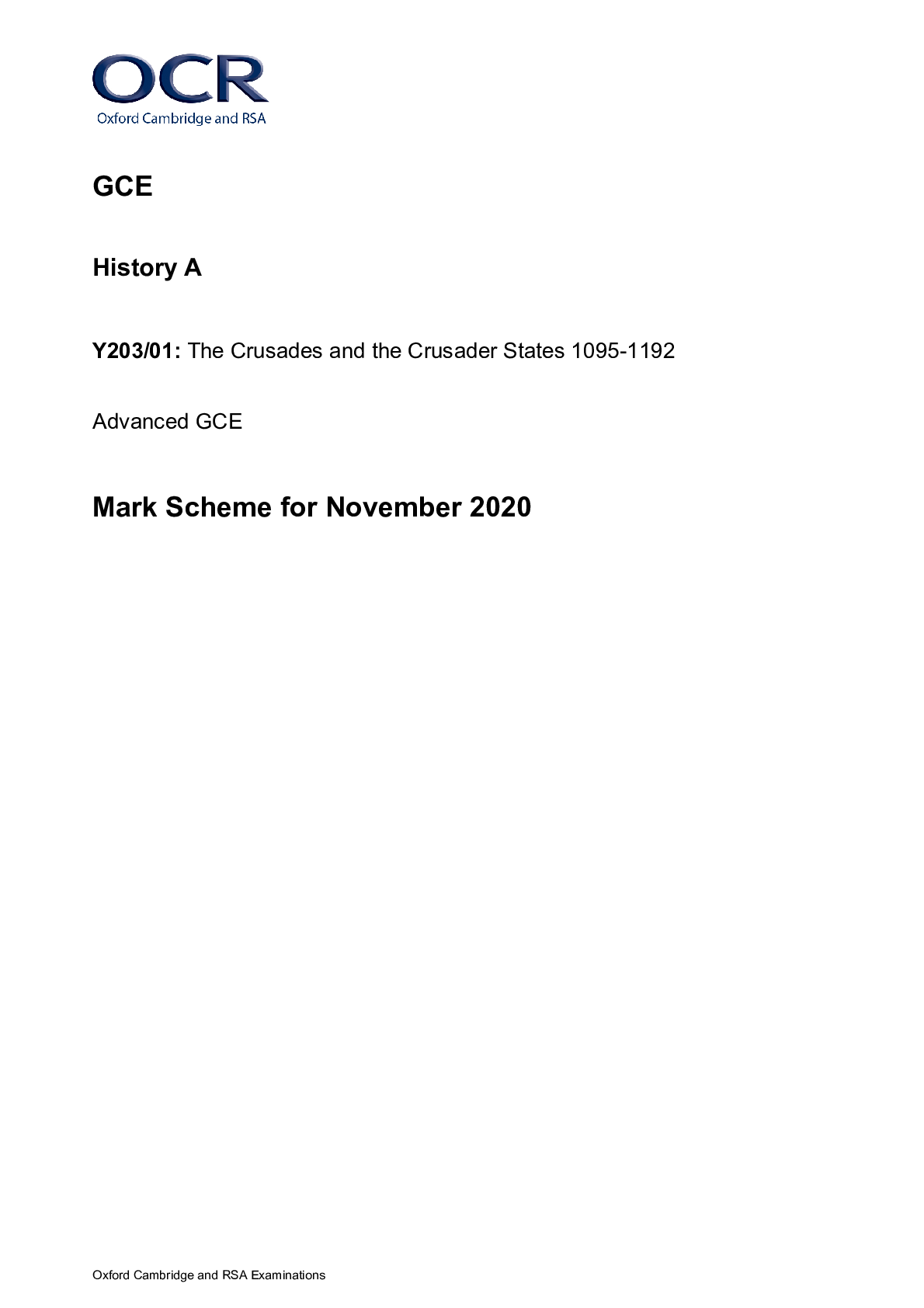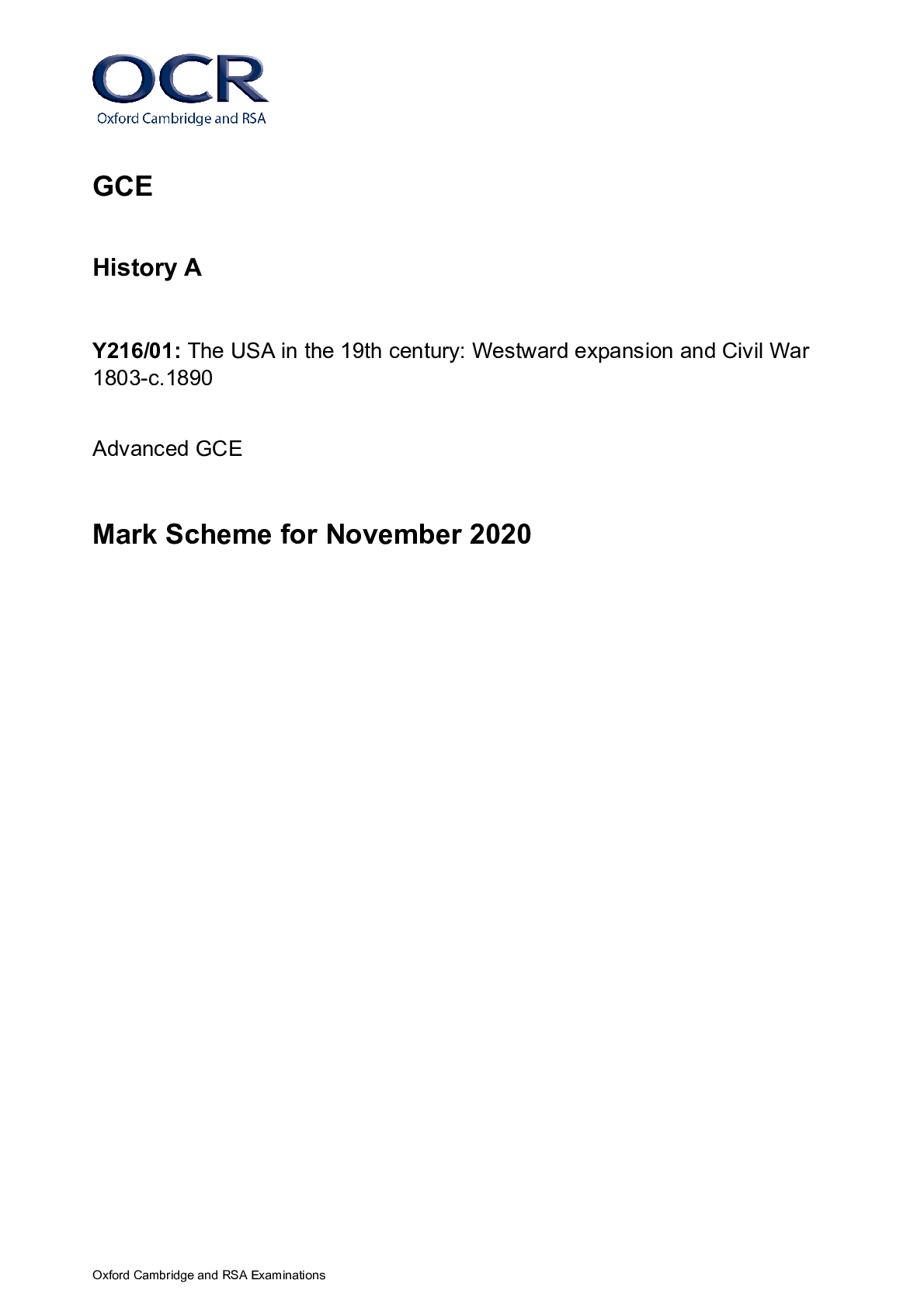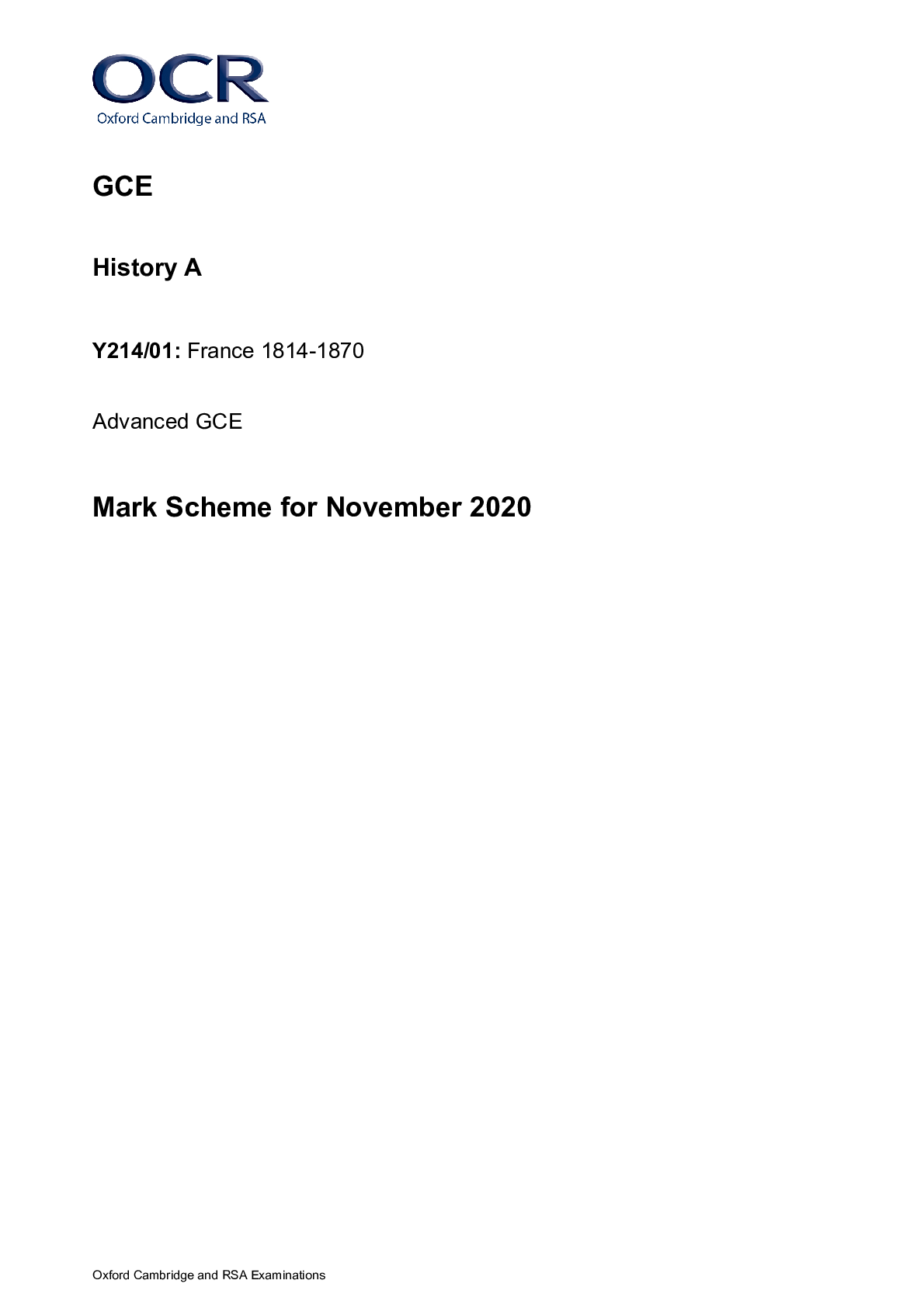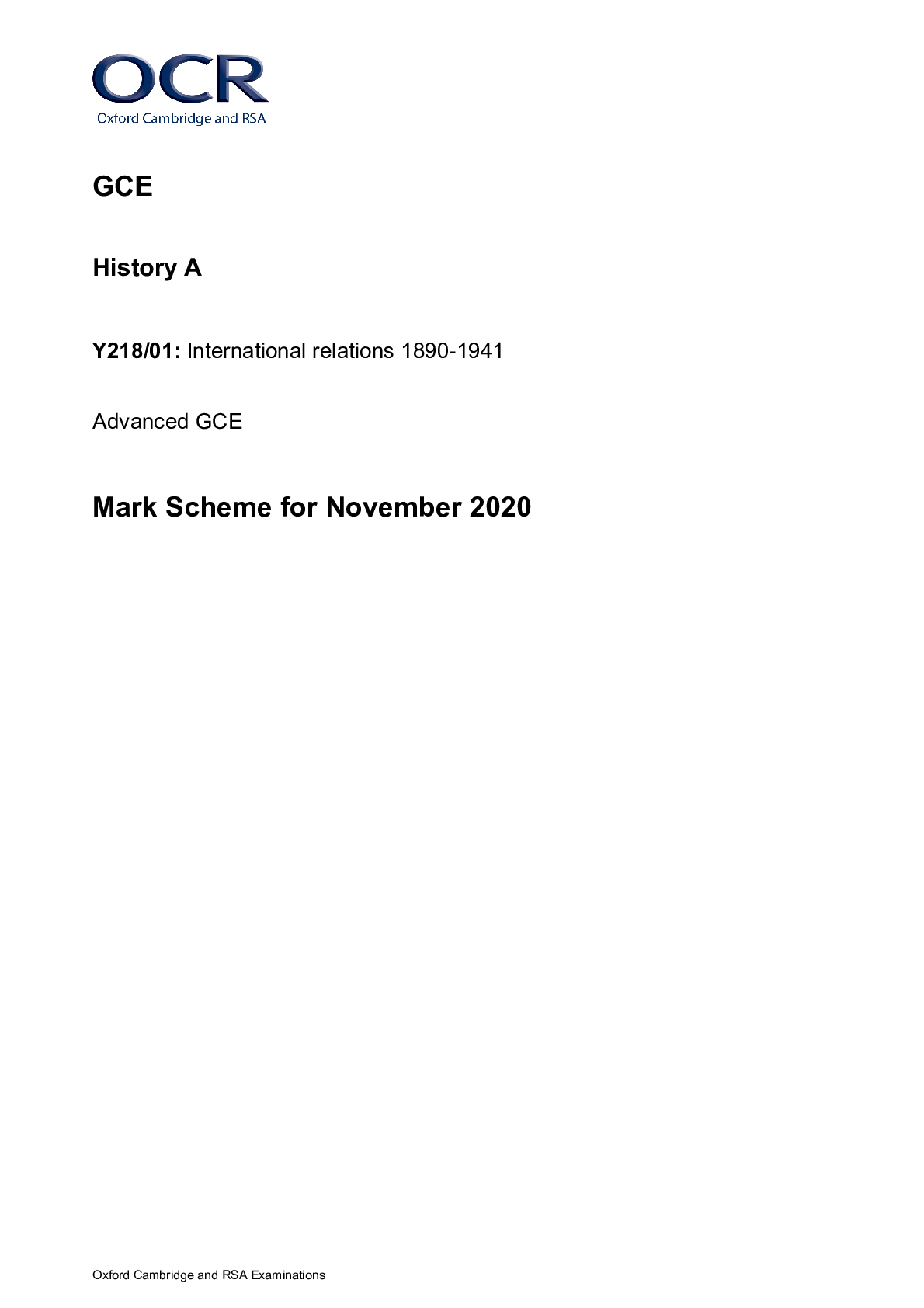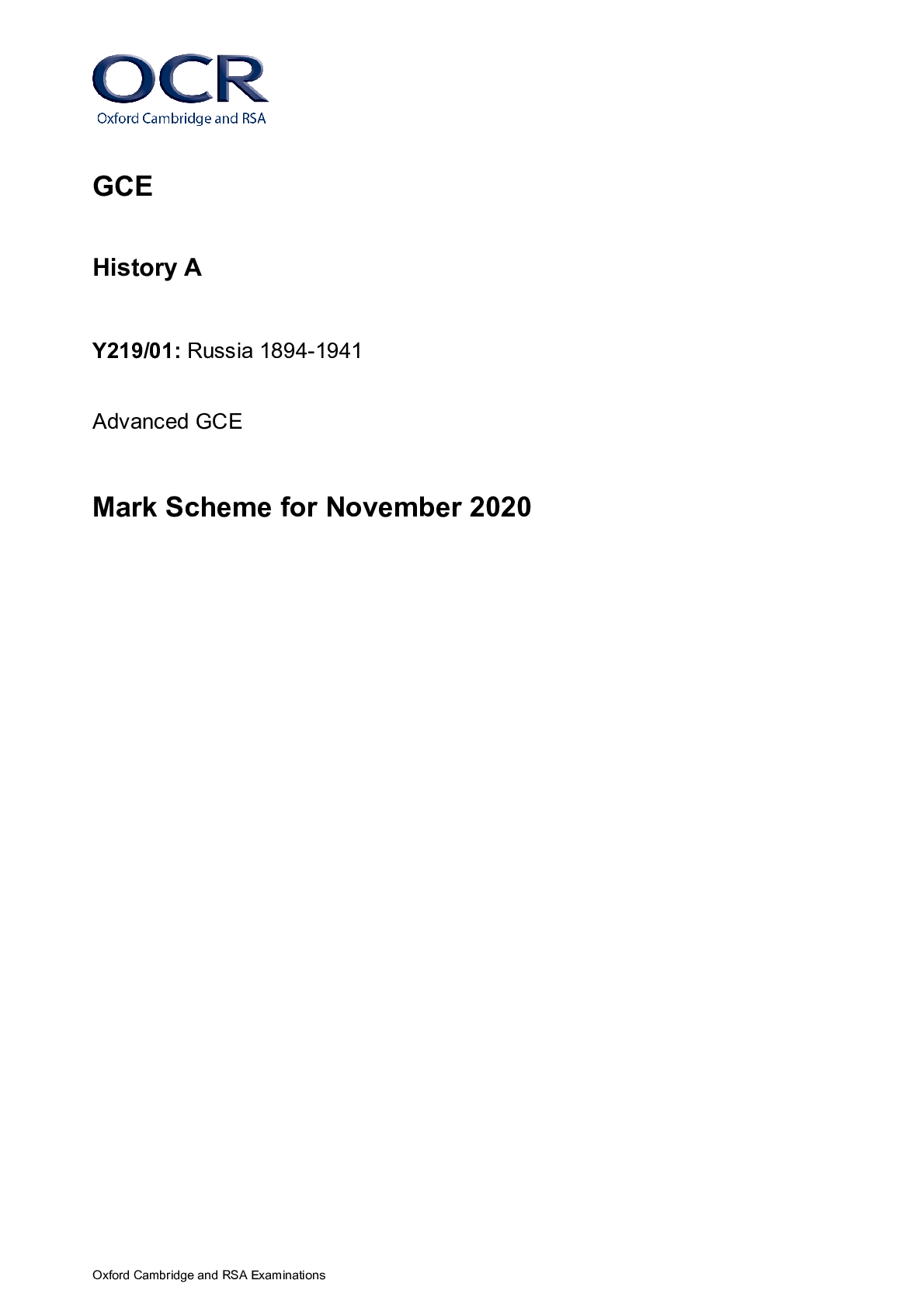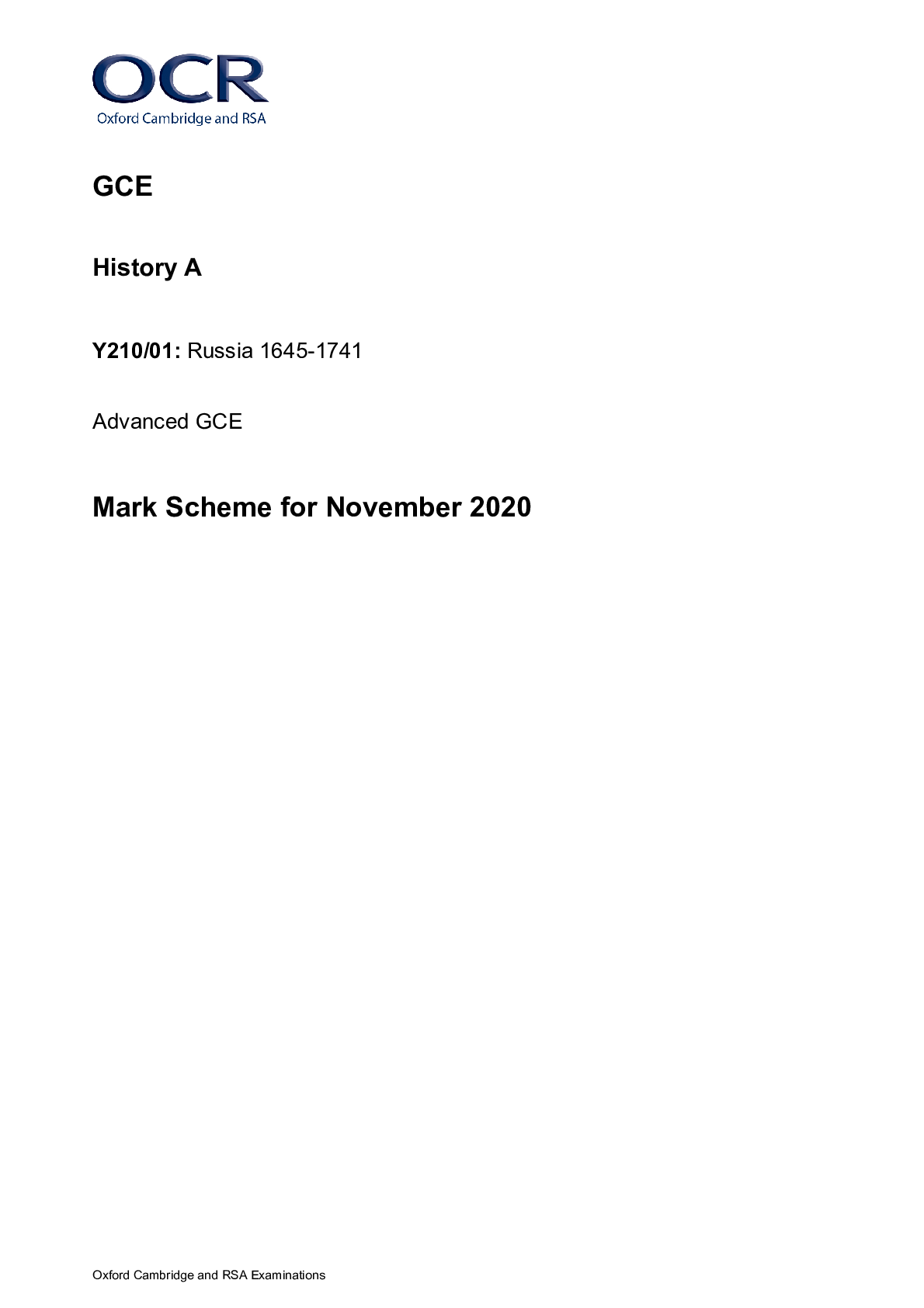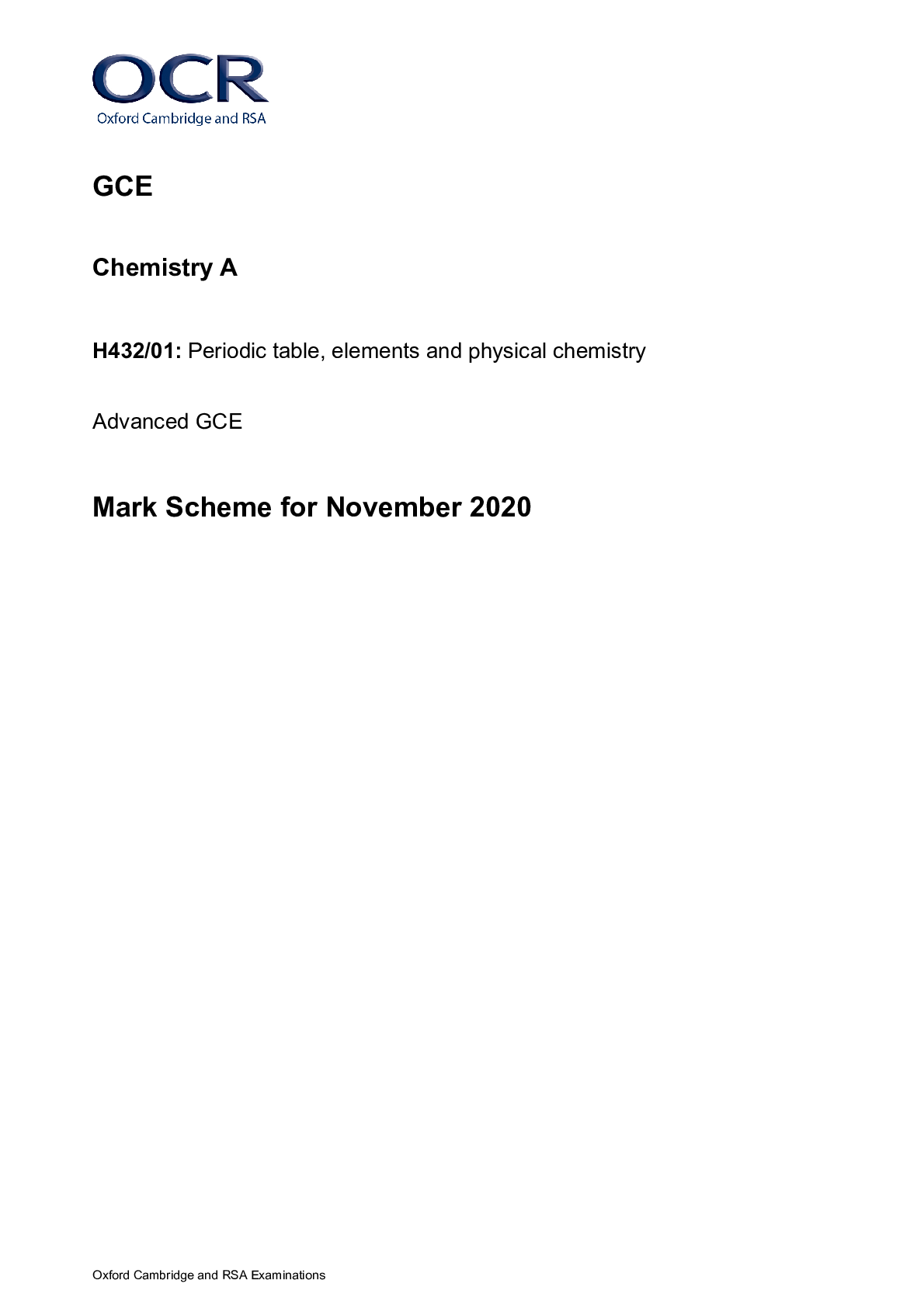Economics > AS Mark Scheme > GCE Economics H060/02: Macroeconomics Advanced Subsidiary GCE Mark Scheme for November 2020 (All)
GCE Economics H060/02: Macroeconomics Advanced Subsidiary GCE Mark Scheme for November 2020
Document Content and Description Below
GCE Economics H060/02: Macroeconomics Advanced Subsidiary GCE Mark Scheme for November 2020 Oxford Cambridge and RSA Examinations GCE Economics H060/02: Macroeconomics Advanced Subsidiary G... CE Mark Scheme for November 2020Oxford Cambridge and RSA Examinations OCR (Oxford Cambridge and RSA) is a leading UK awarding body, providing a wide range of qualifications to meet the needs of candidates of all ages and abilities. OCR qualifications include AS/A Levels, Diplomas, GCSEs, Cambridge Nationals, Cambridge Technicals, Functional Skills, Key Skills, Entry Level qualifications, NVQs and vocational qualifications in areas such as IT, business, languages, teaching/training, administration and secretarial skills. It is also responsible for developing new specifications to meet national requirements and the needs of students and teachers. OCR is a not-for-profit organisation; any surplus made is invested back into the establishment to help towards the development of qualifications and support, which keep pace with the changing needs of today’s society. This mark scheme is published as an aid to teachers and students, to indicate the requirements of the examination. It shows the basis on which marks were awarded by examiners. It does not indicate the details of the discussions which took place at an examiners’ meeting before marking commenced. All examiners are instructed that alternative correct answers and unexpected approaches in candidates’ scripts must be given marks that fairly reflect the relevant knowledge and skills demonstrated. Mark schemes should be read in conjunction with the published question papers and the report on the examination. © OCR 2020H060/02 Mark Scheme November 2020 2 Annotations Annotation Meaning Blank Page – this annotation must be used on all blank pages within an answer booklet and on each page of an additional object where there is no candidate response. Correct – mark awarded Incorrect Benefit of doubt AO1 – Knowledge and understanding AO2 – Apply knowledge and understanding AO3 - Analyse AO4 - Evaluation Not answering question Noted but no credit given Too vague Own figure rule Confused UnclearH060/02 Mark Scheme November 2020 3 12. Subject Specific Marking Instructions INTRODUCTION Your first task as an Examiner is to become thoroughly familiar with the material on which the examination depends. This material includes: • the specification, especially the assessment objectives • the question paper and its rubrics • the mark scheme. You should ensure that you have copies of these materials. You should ensure also that you are familiar with the administrative procedures related to the marking process. These are set out in the OCR booklet Instructions for Examiners. If you are examining for the first time, please read carefully Appendix 5 Introduction to Script Marking: Notes for New Examiners. Please ask for help or guidance whenever you need it. Your first point of contact is your Team Leader. Rubric Infringement Candidates may infringe the rubric in the following way: • answering two questions from Section C. If a candidate has written two answers for Section C, mark both answers and award the highest mark achieved. USING THE MARK SCHEME Please study this Mark Scheme carefully. The Mark Scheme is an integral part of the process that begins with the setting of the question paper and ends with the awarding of grades. Question papers and Mark Schemes are developed in association with each other so that issues of differentiation and positive achievement can be addressed from the very start. This Mark Scheme is a working document; it is not exhaustive; it does not provide ‘correct’ answers. The Mark Scheme can only provide ‘best guesses’ about how the question will work out, and it is subject to revision after we have looked at a wide range of scripts. The Examiners’ Standardisation Meeting will ensure that the Mark Scheme covers the range of candidates’ responses to the questions, and that all Examiners understand and apply the Mark Scheme in the same way. The Mark Scheme will be discussed and amended at the meeting, and administrative procedures will be confirmed. Co–ordination scripts will be issued at the meeting to exemplify aspects of candidates’ responses and achievements; the co– ordination scripts then become part of this Mark Scheme. Before the Standardisation Meeting, you should read and mark a number of scripts, in order to gain an impression of the range of responses and achievement that may be expected. In your marking, you will encounter valid responses which are not covered by the Mark Scheme: these responses must be credited. You will encounter answers which fall outside the ‘target range’ of Bands for the paper which you are marking. Please mark these answers according to the marking criteria. Please read carefully all the scripts in your allocation and make every effort to look positively for achievement throughout the ability range. Always be prepared to use the full range of marks.H060/02 Mark Scheme November 2020 4 INSTRUCTIONS TO EXAMINERS: A INDIVIDUAL ANSWERS 1 The indicative content indicates the expected parameters for candidates’ answers, but be prepared to recognise and credit unexpected approaches where they show relevance. 2 Using ‘best–fit’, decide first which set of BAND DESCRIPTORS best describes the overall quality of the answer. Once the band is located, adjust the mark concentrating on features of the answer which make it stronger or weaker following the guidelines for refinement. • Highest mark: If clear evidence of all the qualities in the band descriptors is shown, the HIGHEST Mark should be awarded. • Lowest mark: If the answer shows the candidate to be borderline (i.e. they have achieved all the qualities of the bands below and show limited evidence of meeting the criteria of the band in question) the LOWEST mark should be awarded. • Middle mark: This mark should be used for candidates who are secure in the band. They are not ‘borderline’ but they have only achieved some of the qualities in the band descriptors. 3 Be prepared to use the full range of marks. Do not reserve (e.g.) high Band 6 marks ‘in case’ something turns up of a quality you have not yet seen. If an answer gives clear evidence of the qualities described in the band descriptors, reward appropriately. B TOTAL MARKS 1 The maximum mark for the paper is 60. 2 The quality of the extended response is assessed on this part of the question paper which is identified with the use of an asterisk (*). The assessment of this skill is embedded within each of the levels of response and it must be considered when determining the mark to be awarded within the appropriate level.H060/02 Mark Scheme November 2020 5 Levels of response / Level descriptors Knowledge and understanding/ Application Analysis Evaluation Strong Precision in the use of the terms in the question and applied in a focused way to the context of the question. An explanation of causes and consequences, fully developing the links in the chain of argument. A conclusion is drawn weighing up both sides, and reaches a supported judgement. Good An explanation of causes and consequences, developing most of the links in the chain of argument. A conclusion is drawn weighing up both sides, but without reaching a supported judgement. Reasonable Awareness of the meaning of the terms in the question and applied to the context of the question. An explanation of causes and consequences, which omit some key links in the chain of argument. Some attempt to come to a conclusion, which shows some recognition of the influencing factors. Limited Awareness of the meaning of the terms in the question. Simple statement(s) of cause and consequence. An unsupported assertion.H060/02 Mark Scheme November 2020 6 Multiple Choice Questions Answer 1 B 2 D 3 B 4 B 5 C 6 A 7 C 8 A 9 D 10 A 11 D 12 A 13 C 14 C 15 BH060/02 Mark Scheme November 2020 7 Question Answer AO Quantitative skills 1 B Rationale: A Defines cyclical budget B Correct: defines crowding out C Defines leakage from circular flow of income D Defines structural unemployment 1 2 D Rationale: A Fiscal balance B Trade balance C Aggregate supply D Correct: Definition of Laffer curve 1 3 B Rationale: A Consumer spending decreases B Correct: Less Investment by firms as more expensive to borrow C More incentive to save D More expensive to borrow so less borrowing 3 4 B Rationale: A Trade surplus B Correct: Budget deficit C Budget surplus D Trade deficit 1 5 C Rationale: A Inflation B Deflation C Correct: Prices increase at a slower rate (a fall in the rate of inflation) D Hyperinflation 1 6 A Rationale: A Correct: (5000 x 0.2)/15000 B (10000 x 0.2)/15000 C (15000 x 0.2)/15000 D 5000/15000 2 Yes 7 C Rationale: A (20-16)/20 = 20% B (20-16)/16 = 25% C Correct: (16-20)/20 = -20% D (16-20)/16 = -25% 2 YesH060/02 Mark Scheme November 2020 8 Question Answer AO Quantitative skills 8 A Rationale: A Correct: Reduce economic growth as exports less competitive B Increase economic growth, exports more competitive C Increase economic growth as more government expenditure D Increase economic growth, more firms likely to enter the market, lower costs for firms means more competitive priced goods 3 9 D Rationale: A 12,500X1.25 = 15,625 ; 14000 – 15625 = (£1,625) B 12,500 - 14,000 X 1.25 = (£1,875) C 14000 – 12500 = £1,500 D Correct: €12,500/1.25 = £10,000; £14000 – £10,000 = £4,000 profit 2 Yes 10 A Rationale: A Correct: As income rises, tax paid as a proportion falls B Progressive C Proportional D Indirect – not related to income 1 11 D Rationale: A AS shifts left B AD shifts left C AD shifts right D Correct AS shifts right 2 12 A Rationale: A: Correct: defines quantitative easing B Exchange rate manipulation C Funding government spending D Exchange rate manipulation 1 13 C Rationale: A Fiscal policy B Monetary policy C Correct: Supply side policy D Monetary policy 1 14 C Rationale: A 100-99.5 B (99.5-93.4)/99.5 C Correct: (99.5-93.4)/93.4 D 100-93.4 2 YesH060/02 Mark Scheme November 2020 9 Question Answer AO Quantitative skills 15 B Rationale: A £0m would be net balance B Correct: -92457+77182+18497 C -92457+77182 D 77182+18497 2 YesH060/02 Mark Scheme November 2020 10 Question Answer Mark Guidance 16 (a) (i) Using Fig. 1, explain the change in household income in Iran from 2007 to 2016. 1 mark for household incomes have fallen/Iranians have become poorer 1 mark for the reference to quantitative change in income 2 (AO2x2) Allow reasonable range for percentage change answers (14% -16%) e.g. ($14700-12500)/14700) = 15.0% Allow a fall of between $2,000 and $2,500. The mark for the use of data must be for a sense of the whole time period from 2007 to 2016. Quantitative skills rewarded in this question 16 (a) (ii) Government expenditure is likely to increase from March 2018 by 6% (lines 10- 11). State why this increase represents, “a cut in real terms”. 1 mark for inflation is higher than 6% 1 (AO1x1) Accept inflation is expected to be around 12% 16 (b) Using Fig. 2, explain what happened to inflation in Iran between 2009 and 2013. Inflation has increased (1) From 10% to 30% (1) By 20%/three-fold (1) 2 (AO1x1 AO2x1) One mark for reference to rise in inflation One mark for reference to a correct figure Quantitative skills rewarded in this questionH060/02 Mark Scheme November 2020 11 Question Answer Mark Guidance 16 (c) Using a diagram, explain what impact these factors may have on economic growth in Iran? Up to 2 marks for a diagram: • Accurate labelling of axes and curves (1) • A leftward shift in AD (1) • Equilibrium Price level & Real GDP lower (1) Up to 2 for explanation: 30 million people will see their cash payments reduced /a significant number of people will be impacted by lower income /High youth unemployment - leading to a fall in consumption(1) Less consumption leads to a fall in AD/ economic growth (1) 4 (AO1x2 AO2x2) Accept real national output (or similar) on the X-axis instead of real GDP Accept a PPF shifting inwards as an alternative diagram Quantitative skills rewarded in this question Diagram must have correct Macro axis labels in order to be awarded marks. A simple statement that AD will shift to the left if already drawn does not gain a mark. An explanation is required. 16 (d) Using information from the case study, explain possible reasons why the Iranian currency, the Rial, has fallen in value by more than 450%? • Demand for the currency has fallen (1) • Increase in supply (1) Evidence from the case study: • Lower demand for oil from other countries (1) • High levels of inflation reducing competitiveness of Iranian exports (1) • Lower demand for Iranian goods due to economic sanctions in the past (1) 4 (AO1x2 AO2x2) Two marks for statements about the reasons for reduced demand for a currency or increased supply. Two marks for reference to evidence in the case study. Allow up to 2 marks for a correct diagram showing a decrease in demand or increase in supply of the currency.H060/02 Mark Scheme November 2020 12 Question Answer Mark Guidance • Reduced sanctions since 2016 may have led to Iranians demanding more imports (1) 16 (e) Explain the difference between unemployment and underemployment. Unemployment is not having a job while being able to work (1) whilst underemployment is having a job but working less hours than you would like to (1). 2 AO1x2 One mark for a definition of either term. Two marks for clear definitions showing the distinction between the two terms. 16 (f) Evaluate the advantages of international trade to an emerging country, such as Iran, if it were allowed to trade freely. Level 3 (7-10 marks) Good – strong analysis of the benefits of international trade for an emerging country. Good analysis will be in the form of developed links. These links are developed through a chain of reasoning which addresses the question. Any relevant diagram(s) are predominantly correct and linked to the analysis. Strong analysis will have consistently well-developed links through a coherent chain of reasoning which addresses the question. Any relevant diagram(s) are predominantly correct with no significant errors that affect the validity of the analysis. Any diagrams must be integral to the analysis. Good - strong evaluation of the benefits of international trade for an emerging country. Strong evaluation should include a supported judgement. 10 (AO2 x1 AO3 x 4 AO4 x 5) Examples of analysis may include: Exports are a component of AD, therefore international trade will help economic growth - which had contracted in 2015 by 1.4%. Unemployment is high at 12.4%. With removed protectionism firms have greater access to foreign markets. Potential rising foreign demand would require additional labour to produce those exports which would help to reduce the unemployment level. As more people are employed, this improves their standard of living and as they spend their wages. AD increases and, via a multiplier effect, contributes to economic growth. Access to global markets would allow Iran to import more easily and allow the country to import capital goods/access to technology which would help the economy’s productive potential and long-term growth. Imports of foodstuffs, may help to reduce the rising price of food which has increased by around 40% and reduce inflation. Consumers would have access to products not produced in Iran. This may encourage local firms to become more innovative and produce higher quality products at lower prices as competition increases. This may help to reduce the increasing levels of poverty and reduced consumption of basic foodstuffs. Examples of evaluation could include:H060/02 Mark Scheme November 2020 13 Question Answer Mark Guidance There is a well-developed line of reasoning which is clear and logically structured. The information presented is relevant and substantiated. Level 2 (4-6 marks) Reasonable analysis of the benefits of international trade. There is correct analysis largely in the form of single links. These address the question but are not developed into a clear chain of reasoning. Any relevant diagram(s) may be imperfectly labelled or not linked to the analysis. Reasonable evaluation of the benefits of international trade. There is a line of reasoning presented with some structure. The information presented is in the most part relevant and supported by some evidence. Level 1 (1-3 marks) Limited analysis based on application of knowledge and understanding of the benefits of international trade. There is little evidence of reasoning that addresses the question asked. There is a lack of a clear structure. Any relevant diagram(s) may not be present or are incorrectly labelled. Limited evaluation of the benefits of international trade in the form of an unsupported statement or no evaluation. Falling unemployment may contribute to cost push inflation which is already high at around 12%. Rising demand may require increased imports of raw materials/energy. With a weak exchange rate this will lead to balance of payments issues and /or cost push inflation. As consumers purchase foreign products this may reduce demand for local products and firms may shut down causing unemployment to rise. With tariffs in place the government may be able to collect some revenue which it could use to invest in infrastructure, R&D and subsidies to business to encourage the economy to be less reliant on oil, so increasing employment levels. Demand would increase for the Iran Rial. As the currency appreciates this may mean exports become less competitive relative to other countries. However, the Rial has fallen in value by 450%, so this is less likely to be an issue.H060/02 Mark Scheme November 2020 14 Question Answer Mark Guidance Information is basic and communicated in an unstructured way. The information is supported by limited evidence. The relationship to the evidence may not be clear. 0 marks no response worthy of credit Descriptor Award mark Consistently meets the criteria for this level At top of level Meets the criteria but with some slight inconsistency Above middle and either below top of level or at middle of level (depending on number of marks available) Just enough achievement on balance for this level Above bottom and either below middle or at middle of level (depending on number of marks available) On the borderline of this level and the one below At bottom of levelH060/02 Mark Scheme November 2020 15 Question Answer Mark Guidance 17* Evaluate, using an appropriate diagram(s), the effects of this change in taxation on the Japanese government’s ability to achieve macroeconomic objectives. Level 4 (16-20 marks) Good knowledge and understanding of how an increase in taxes may affect other macroeconomic objectives. Strong analysis will have consistently well-developed links through a coherent chain of reasoning which addresses the question. Any relevant diagram(s) are predominantly correct with no significant errors that affect the validity of the analysis. Any diagrams must be integral to the analysis. Strong evaluation of the extent of how a change in taxation may affect other macroeconomic objectives, weighing up both sides/comparing alternatives and reaching a supported judgement. There is a well-developed line of reasoning which is clear and logically structured. The information presented is relevant and substantiated. Level 3 (11-15 marks) Good knowledge and understanding of how an increase in taxes may affect other macroeconomic objectives. Good analysis of how a change in taxation affects other macroeconomic objectives. There is correct analysis in the form of developed links. These links are developed through a chain of reasoning which addresses the question. Any relevant diagram(s) are predominantly correct and linked to the analysis. 20 (AO1*3 AO2*4 AO3*6 AO4*7) Macroeconomic objectives include low and stable inflation, full employment, sustained and sustainable economic growth, more equal distribution of income and a sustainable balance of payment position. There have been changes to direct taxation- higher rate income tax at the top end, indirect taxes - tax on smoking and a departure tax change. This may help the Japanese government to earn more tax revenue and therefore help to reduce fiscal deficit/attain balanced budget. This may provide funds to increase government spending which could increase AD in the short term and lead to LR economic growth. However, this depends on whether the government increases government expenditure as government revenue increases. The level of income equality is likely to improve as income taxes become more progressive and higher income earners are paying more taxes. If the additional tax revenue is spent by the government on areas such as welfare benefits, healthcare and education this will further benefit lower income earners. The effect of the income tax change depends on the extent of how disincentivised higher income workers are. Workers may work less hours – (c.f. Laffer curve). Income tax revenue may not increase by as much as expected due to tax evasion and also tax avoidance. Tax evasion maybe be difficult if there are strong governance systems in place. As income taxes increase this is an increased withdrawal from the circular flow of income and will reduce AD from AD1 to AD2.H060/02 Mark Scheme November 2020 16 Question Answer Mark Guidance Good evaluation will weigh up both sides/comparing alternatives but without reaching a supported judgement. There is a line of reasoning presented with some structure. The information presented is in the most part relevant and supported by some evidence. Level 2 (6-10 marks) Reasonable knowledge and understanding of how an increase in taxes may affect other macroeconomic objectives. Reasonable analysis of the impact of changes in taxation on other macroeconomic objectives. There is correct analysis largely in the form of single links. These address the question but are not developed into a clear chain of reasoning. The relevant diagram(s), if present, may be imperfectly labelled or not linked to the analysis. Reasonable evaluation of the impact of an increase in taxes on other macroeconomic objectives. The information has some relevance and is presented with limited structure. The information is supported by limited evidence. Level 1 (1-5 marks) Limited knowledge and understanding of how an increase in taxes may affect other macroeconomic objectives. Limited or no analysis of the impact of how an increase in taxes affects other macroeconomic objectives. There is little evidence of reasoning that addresses the question asked. There is a lack of a clear structure. The relevant diagram(s) may not be present or incorrectly labelled. This is likely to increase unemployment which is likely to reduce incomes and the standard of living and increase income inequality. Depending on the multiplier this will then have further effects on consumption in the economy – revenue earned from indirect taxes may fall. Savings levels may also increase due to uncertainty as unemployment increases, all of which further impact AD and economic growth. The effect will depend on the size of the multiplier. The level of inflation is likely to fall as demand in the economy falls so may help the government achieve its inflationary targets if inflation is high. Depending on the level of inflation in the economy this could be deflationary. A lower level of inflation may also reduce pressure for higher wages. This may then increase the competitiveness of Japanese goods relative to other countries and may help increase exports and employment. This may then help improve the balance of payments. However, this is also likely to depend on other factors, such as the exchange rate relative to major trading partners and non-price factors such as quality of products. However, if the government spends the additional tax revenue gained, e.g. investment in infrastructure, there will no/less of a negative impact on AD/employment and economic growth. Government spending on supply side policies such as investment in infrastructure, R&D, training will also help reduce inflation.H060/02 Mark Scheme November 2020 17 Question Answer Mark Guidance Limited evaluation of the impact of how an increase in taxes affects other macroeconomic objectives, in the form of an unsupported statement or no evaluation. Information is basic and communicated in an unstructured way. The information is supported by limited evidence. The relationship to the evidence may not be clear. 0 marks no response worthy of credit Increasing smoking taxes may also lead to smokers bringing in cigarettes from abroad which will then impact government revenue. The increased imports may have a negative impact upon the balance of payments. Departure tax may deter tourists from going to Japan which will have a negative impact on aggregate demand and the balance of payments. However, it is likely that tourist expenditure only makes up a small proportion of AD and therefore the impact on economic growth and unemployment will be small/offset by the extra tax collected from those tourists that still do travel to the country. Descriptor Award mark Consistently meets the criteria for this level At top of level Meets the criteria but with some slight inconsistency Above middle and either below top of level or at middle of level (depending on number of marks available) Meets most of the criteria with some inconsistencies Middle of level Just enough achievement on balance for this level Above bottom and either below middle or at middle of level (depending on number of marks available) On the borderline of this level and the one below At bottom of levelH060/02 Mark Scheme November 2020 18 18* Evaluate, using an appropriate diagram(s), whether a large current account imbalance should be a concern for any government. Level 4 (16-20 marks) Good knowledge and understanding of whether a large current account imbalance is a concern. Strong analysis will have consistently well-developed links through a coherent chain of reasoning which addresses the question. Any relevant diagram(s) are predominantly correct with no significant errors that affect the validity of the analysis. Any diagrams must be integral to the analysis. Strong evaluation of the extent to whether a large current account imbalance is a concern and reaching a supported judgement. There is a well-developed line of reasoning which is clear and logically structured. The information presented is relevant and substantiated. Level 3 (11-15 marks) Good knowledge and understanding of whether a large current account imbalance is a concern Good analysis of whether a large current account imbalance is a concern. There is correct analysis in the form of developed links. These links are developed through a chain of reasoning which addresses the question. Any relevant diagram(s) are predominantly correct and linked to the analysis. Good evaluation will weigh up whether a large current account imbalance is a concern but without reaching a supported judgement. 20 (AO1*3 AO2*4 AO3*6 AO4*7) A large deficit would be a concern as it means imports exceed exports. Imports are a withdrawal from the circular flow of income, so lead to a fall in aggregate demand (AD1-AD2) as more foreign goods (and less domestic goods) are demanded by citizens. In addition, less exports may be being sold abroad. (Y1-Y2 falling growth/output)). This may lead to domestic firms reducing staff and/or closing which increases domestic unemployment. This may lead to an increase in government expenditure on welfare payments whilst receiving less tax revenue from firms and individuals negatively impacting government finances and potentially adding to the national debt. A trade deficit may mean that citizens are enjoying consuming high level of products (at cheap prices) and therefore a higher standard of living. However, it may suggest the economy is unbalanced with the focus on short term consumption. The deficit will be less of a concern if it is caused by imports of capital goods which will create value in the economy through increased output of goods which can be sold domestically or overseas. Productivity may also improve increasing the competitiveness of such goods. A current account deficit may mean the currency depreciates as there is lower demand which would mean imports become more expensiveH060/02 Mark Scheme November 2020 19 There is a line of reasoning presented with some structure. The information presented is in the most part relevant and supported by some evidence. Level 2 (6-10 marks) Reasonable knowledge and understanding of whether a large current account imbalance is a concern. Reasonable analysis of whether a large current account imbalance is a concern There is correct analysis largely in the form of single links. These address the question but are not developed into a clear chain of reasoning. The relevant diagram(s), if present, may be imperfectly labelled or not linked to the analysis. Reasonable evaluation of whether a large current account imbalance is a concern. The information has some relevance and is presented with limited structure. The information is supported by limited evidence. Level 1 (1-5 marks) Limited knowledge and understanding of whether a large current account imbalance is a concern Limited or no analysis of whether a large current account imbalance is a concern. There is little evidence of reasoning that addresses the question asked. There is a lack of a clear structure. The relevant diagram(s) may not be present or incorrectly labelled. Limited evaluation of whether a large current account imbalance is a concern, in the form of an unsupported statement or no evaluation. and if raw materials such as oil are being imported may contribute to cost push inflation. However, as the currency depreciates this may mean domestic products become cheaper increasing demand for exports. If the deficit has been financed from borrowing abroad it may be unsustainable and may lead to high interest payments. However, it depends on how large the current account deficit is – an increase of 24% seems very large. It depends how long the trade deficit remains large, it is more of a concern if the trade balance is in deficit over a long time period, as it may signal the country’s goods are uncompetitive/poor quality. It also depends on the size of the deficit relative to GDP, a £9.7bn trade deficit is maybe less of a problem to the UK than a small developing country. China has a large surplus on its current account suggesting they are exporting more products than they are importing and therefore a sign of export strength and Chinese products are very attractive to foreigners. This should be positive for employment and growth but lead to an increase in inflation as demand for goods is rising faster than supply. Whilst, the surplus in China has fallen in recent months it is still very high. This may indicate that the exchange rate is undervalued as rising demand should encourage lead to rising exchange rate if exchange rate is free floating. This could lead to criticism, potentially tariffs and trade wars with trading partners. More balanced trade would increase the level of imported goods into a country and increase real incomes and lead to a higher standard of living as the value of its currency rises. This will allow for more inflows of foreign capital from abroad stimulating growth in the domestic economy. Better answers will consider the general implications/consequences of an imbalance, rather than just the factors causing the surplus or deficit.H060/02 Mark Scheme November 2020 20 Information is basic and communicated in an unstructured way. The information is supported by limited evidence. The relationship to the evidence may not be clear. 0 marks no response worthy of credit Descriptor Award mark Consistently meets the criteria for this level At top of level Meets the criteria but with some slight inconsistency Above middle and either below top of level or at middle of level (depending on number of marks available) Meets most of the criteria with some inconsistencies Middle of level Just enough achievement on balance for this level Above bottom and either below middle or at middle of level (depending on number of marks available) On the borderline of this level and the one below At bottom of level Assessment Objectives Grid Question AO1 AO2 AO3 AO4 Total 1 to 15 7 6 2 15 (5) 16(a)(i) 2 (2) 2 (2) 16(a)(ii) 1 1 (b) 1 1 (1) 2 (1) (c) 2 2 (2) 4 (2) (d) 2 2 4 (e) 2 2 (f) 1 4 5 10 17 or 18 3 4 (2) 6 (3) 7 (3) 20 (8) Total 18 18 12 12 60 (18)OCR (Oxford Cambridge and RSA Examinations) The Triangle Building Shaftesbury Road Cambridge CB2 8EA [Show More]
Last updated: 1 year ago
Preview 1 out of 22 pages
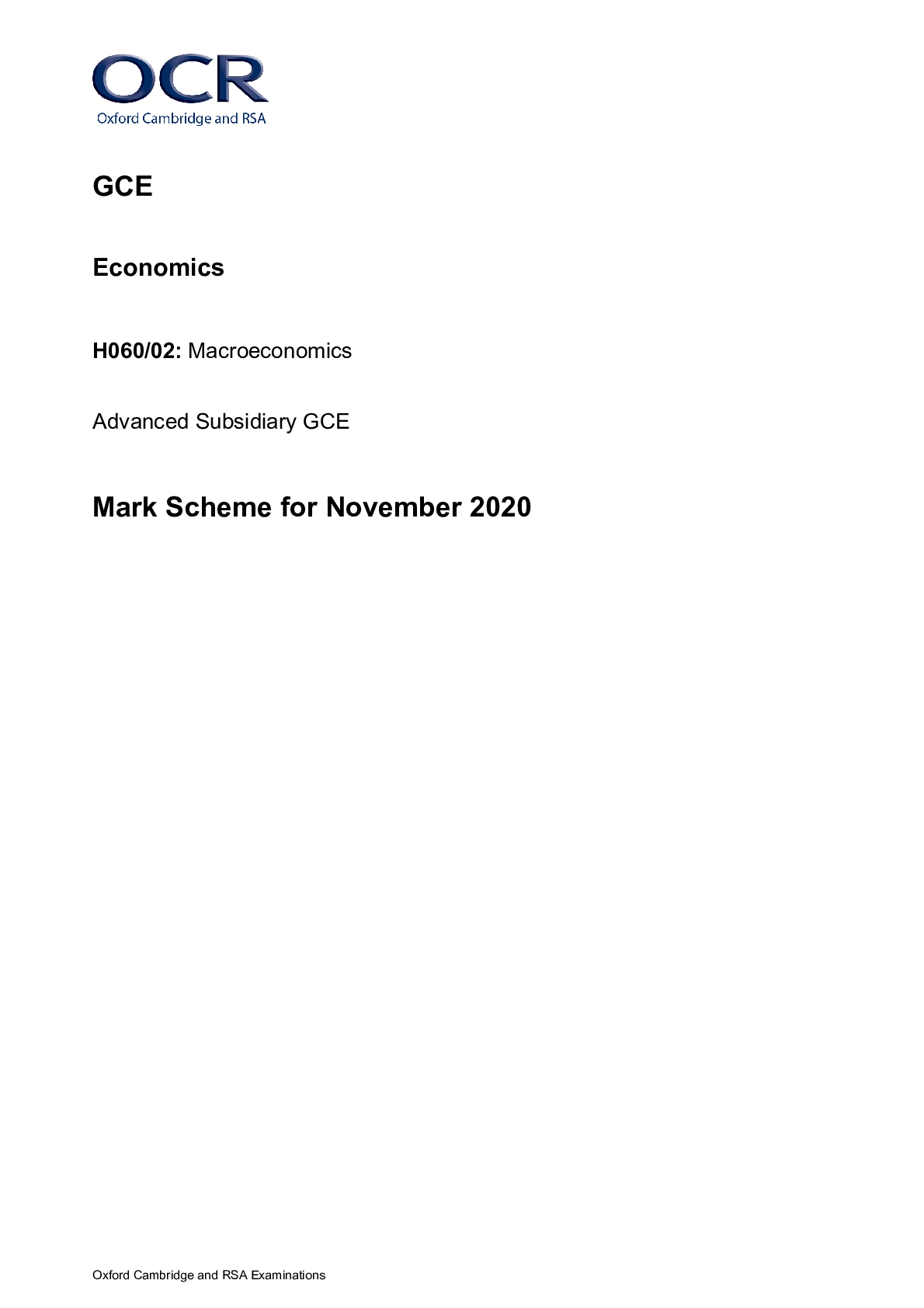
Reviews( 0 )
Document information
Connected school, study & course
About the document
Uploaded On
Oct 10, 2022
Number of pages
22
Written in
Additional information
This document has been written for:
Uploaded
Oct 10, 2022
Downloads
0
Views
95

